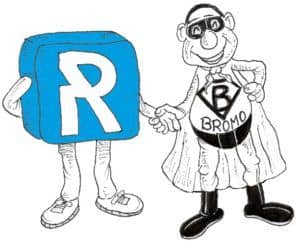
05 Jul What is bromine used for?
No idea, it must be good for something. Is it an App? Is it an ingredient of molecular gastronomy?…..These are possible answers to the questions posed by a headline containing bromine, a substance known to only a few but which is quite unpopular by its well-known victim, legionella.
A lot is said and written about legionella and its undesirable presence, but aside from knowing that it can be very harmful, many times little more is known about it. Here are some answers to possible questions:
What is it?
A bacteria whose first and last names are: legionella pneumofila.
Where does it live?
In water, but not in salt water.
When is there a risk?
When installations that produce aerosols allow it to propagate itself through the air within tiny water droplets. These are installations such as cooling towers, spas, Jacuzzis,….
What happens with these tiny water droplets?
We can inhale them. The only entry point to our organism is through the respiratory system, and they affect our lungs. Incidentally, it is not contagious.
How can we combat it?
The water of the distribution network already contains this bothersome tenant. We must therefore see to it that it does not find the necessary conditions for it to procreate in our installations and reach high risk levels.
With what weapons?
- Temperatures it does not like: it thrives between 20ºC y 45ºC, whereas under 20ºC it remains present but without multiplying, and temperatures above 70ºC kill it.
- Eliminating its diet: its culinary preferences are a bit strange, seeing that it feeds on mud, zinc or iron derived from corrosion and organic matter. Proper maintenance and cleaning of the installation will put an end to its diet.
- Attacking it with products it doesn’t like: chlorine or biocides will finish it off. The correct dosage of these products will keep it under control.
How does bromine relate to all of this?
There are cooling towers in Rieusset and we have had to arm ourselves with the necessary weapons to combat legionella. Part of this tactic is the continuous dosing of a biocide product using a pump, although we must make sure on a daily basis that the water in the cooling circuit, of which the tower is a part, contains the correct concentration of biocide. The absence or low concentration of biocide would make it possible for legionella to proliferate.
The regular, programmed pumping of biocide does not guarantee that the presence thereof is at all times the desired one, since the biocide is delivered according to a schedule regardless of its concentration in t
With this new acquisition we can guarantee the adequate presence of biocide, additionally to acting with bromine, wherefore the microorganisms are unable to develop resistance. Additionally, this produces a desirable control effect on the biofilms, which are nothing more than small accumulations of mud, organic matter,… where legionella can thrive, since these are its little restaurant.
Is it clear now what bromine is good for, or is it still a stranger waiting to be presented?
| We Manufacture: | Meet Rieusset: |



